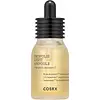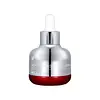What's inside
What's inside
 Key Ingredients
Key Ingredients

 Benefits
Benefits

 Concerns
Concerns

No concerns
 Ingredients Side-by-side
Ingredients Side-by-side

Water
Skin ConditioningButylene Glycol
HumectantGlycerin
HumectantNiacinamide
SmoothingSodium Hyaluronate
HumectantNatto Gum
Theobroma Cacao Extract
Skin ConditioningBeta-Glucan
Skin ConditioningBis-PEG-18 Methyl Ether Dimethyl Silane
EmollientPhenyl Trimethicone
Skin ConditioningTriethanolamine
BufferingCarbomer
Emulsion StabilisingXanthan Gum
EmulsifyingLecithin
EmollientTocopheryl Acetate
AntioxidantCaprylic/Capric Triglyceride
MaskingUbiquinone
AntioxidantDiisopropyl Adipate
EmollientAlcohol
AntimicrobialLavandula Angustifolia Flower Extract
CleansingRosmarinus Officinalis Leaf Extract
AntimicrobialCornus Officinalis Fruit Extract
Skin ConditioningAloe Barbadensis Leaf Extract
EmollientBetula Platyphylla Japonica Juice
Skin ConditioningVitis Vinifera Seed Extract
AntimicrobialAdenosine
Skin ConditioningDisodium EDTA
Caprylyl Glycol
EmollientEthylhexylglycerin
Skin ConditioningTropolone
Skin ConditioningCI 19140
Cosmetic ColorantWater, Butylene Glycol, Glycerin, Niacinamide, Sodium Hyaluronate, Natto Gum, Theobroma Cacao Extract, Beta-Glucan, Bis-PEG-18 Methyl Ether Dimethyl Silane, Phenyl Trimethicone, Triethanolamine, Carbomer, Xanthan Gum, Lecithin, Tocopheryl Acetate, Caprylic/Capric Triglyceride, Ubiquinone, Diisopropyl Adipate, Alcohol, Lavandula Angustifolia Flower Extract, Rosmarinus Officinalis Leaf Extract, Cornus Officinalis Fruit Extract, Aloe Barbadensis Leaf Extract, Betula Platyphylla Japonica Juice, Vitis Vinifera Seed Extract, Adenosine, Disodium EDTA, Caprylyl Glycol, Ethylhexylglycerin, Tropolone, CI 19140
 Reviews
Reviews

Ingredients Explained
These ingredients are found in both products.
Ingredients higher up in an ingredient list are typically present in a larger amount.
Butylene Glycol (or BG) is used within cosmetic products for a few different reasons:
Overall, Butylene Glycol is a safe and well-rounded ingredient that works well with other ingredients.
Though this ingredient works well with most skin types, some people with sensitive skin may experience a reaction such as allergic rashes, closed comedones, or itchiness.
Learn more about Butylene GlycolCarbomer is a polymer of acrylic acid. Its main role is to create a gel consistency.
A high amount of carbomer can cause pilling or balling up of products. Don't worry, most products contain 1% or less of carbomer.
Glycerin is already naturally found in your skin. It helps moisturize and protect your skin.
A study from 2016 found glycerin to be more effective as a humectant than AHAs and hyaluronic acid.
As a humectant, it helps the skin stay hydrated by pulling moisture to your skin. The low molecular weight of glycerin allows it to pull moisture into the deeper layers of your skin.
Hydrated skin improves your skin barrier; Your skin barrier helps protect against irritants and bacteria.
Glycerin has also been found to have antimicrobial and antiviral properties. Due to these properties, glycerin is often used in wound and burn treatments.
In cosmetics, glycerin is usually derived from plants such as soybean or palm. However, it can also be sourced from animals, such as tallow or animal fat.
This ingredient is organic, colorless, odorless, and non-toxic.
Glycerin is the name for this ingredient in American English. British English uses Glycerol/Glycerine.
Learn more about GlycerinSodium Hyaluronate is hyaluronic acid's salt form. It is commonly derived from the sodium salt of hyaluronic acid.
Like hyaluronic acid, it is great at holding water and acts as a humectant. This makes it a great skin hydrating ingredient.
Sodium Hyaluronate is naturally occurring in our bodies and is mostly found in eye fluid and joints.
These are some other common types of Hyaluronic Acid:
Learn more about Sodium Hyaluronate